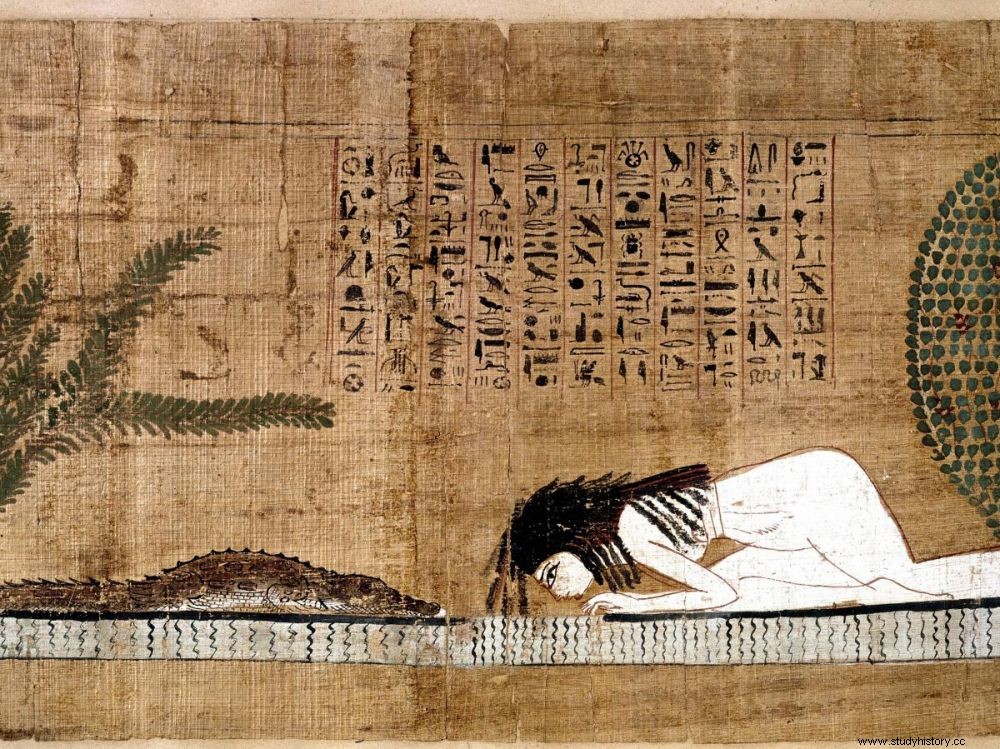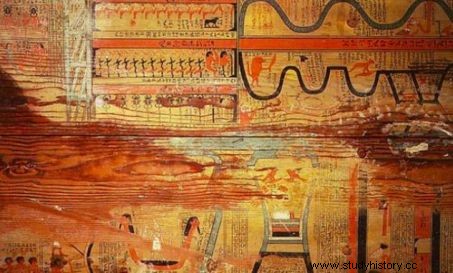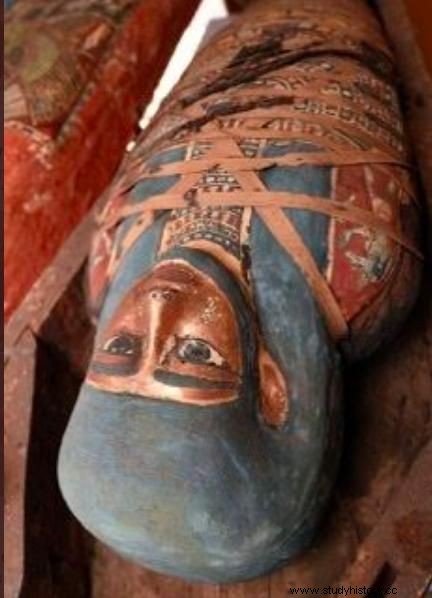A collection of formulas found in one of the 59 sarcophagi exhumed on October 4, 2020 on the Saqqara plateau, in the heart of the ancient necropolis of Memphis, in Egypt, turned out to be one of the oldest versions of Book of the Dead .

Deceased worshiping a crocodile symbol of fertility, detail of a papyrus from the Book of the Dead, Egyptian Museum in Cairo (Egypt).
Perfectly preserved, sporting dazzling colors, around sixty sarcophagi were recently brought up, through narrow passages, from the deep underground galleries of the funerary complex of Saqqara, south of Cairo, where they had been buried for millennia. Brought back to the light of day, and subjected to a first battery of examinations, these preliminary analyzes led the Egyptian archaeologists to an astonishing discovery. According to Egypt Today , the writings found on the walls of one of the sarcophagi would be linked to one of the most illustrious funerary texts of ancient Egypt:that of the Book of the Dead . A 4,000 year old version, which could be its oldest variant!

Detail of the inscription linked to the Book of the Dead inside a sarcophagus discovered in October 2020 in the necropolis of Saqqara (Egypt). Credit:Egypt Today
The ancient Egyptians believed in resurrection. And traditionally, religious texts accompanied the deceased to the grave. Their function was to provide the dead with instructions to follow in order to survive in the afterlife. To do this, since the beginning of the New Kingdom (1539-1080 BC), and the 18 th dynasty, the Book of the Dead served as a reference. (A usage that lasted for nearly 1,500 years). "It was a compilation of heterogeneous formulas of various origins and contents, which had in common to be mobilized to facilitate the deceased the enjoyment of a second life in the afterlife" , explains Pascal Vernus, Egyptologist and director of studies at the Practical School for Advanced Studies (EPHE), in Paris, joined by Sciences et Avenir .
Instructions for overcoming the dangers of the afterlife
The function of these formulas was to assist the deceased in each of the steps to be taken in the dangerous journey that awaited him in the kingdom of the dead. Thus, by pronouncing some of these magic formulas, he could emancipate himself from the most perilous obstacles. exorcise its dangers. Intended for individuals, this collection of formulas was generally copied from a papyrus that the ancient Egyptians called the "Book of going out by day", and which the German scholar Karl Richard Lepsius (1810-1884), baptized "Book of the dead". "Since the New Kingdom, the formulas of these texts have varied greatly, until the Late Period (664-332 BC) where canonical versions are clearly discerned" , continues the specialist.
However, pre-existing the Book of the Dead , until the Middle Kingdom (around 2022-1650 BC), these formulas were most often reproduced directly on the walls of sarcophagi, hence their name Sarcophagus Texts . As for the Book of the dead, there were no canonical versions. Codified. We could then find other funerary books, the Book of the two paths —real topographical map of the afterlife, with the location of the dangers —, but also the Book of Shou , or the Book of the Four Winds .

Example of the remarkable state of preservation of the mummies and sarcophagi discovered in 2020 on the Saqqara plateau, near Cairo. Credits:Egyptian Ministry of Antiquities.
The importance of the discovery made at the beginning of October 2020, is that we would have found inscribed, 4,000 years ago, on one of the sarcophagi of Saqqara dating back to the beginning of the Middle Kingdom, (reign of Pharaoh Montuhotep II) , a formula that was known until then only many centuries later, in the Book of the Dead of the New Kingdom. Enough to increase knowledge on the precursory links that these different texts may have maintained.
Listed as a UNESCO World Heritage Site in 1979, the site of Saqqara has revealed many archaeological treasures. Since the beginning of 2020, the Egyptian Ministry of Tourism and Antiquities has constantly announced important discoveries, qualifying that of the sarcophagi of Saqqara, and among them, this ancient text, as the most important of the year.
